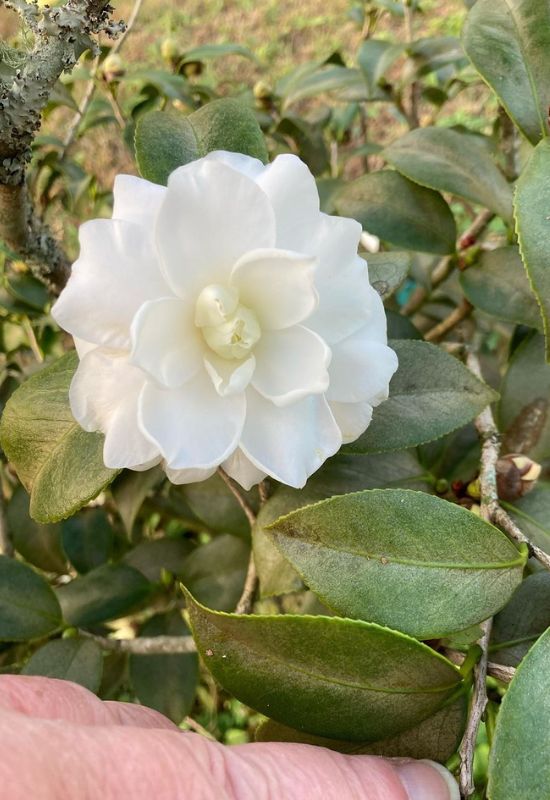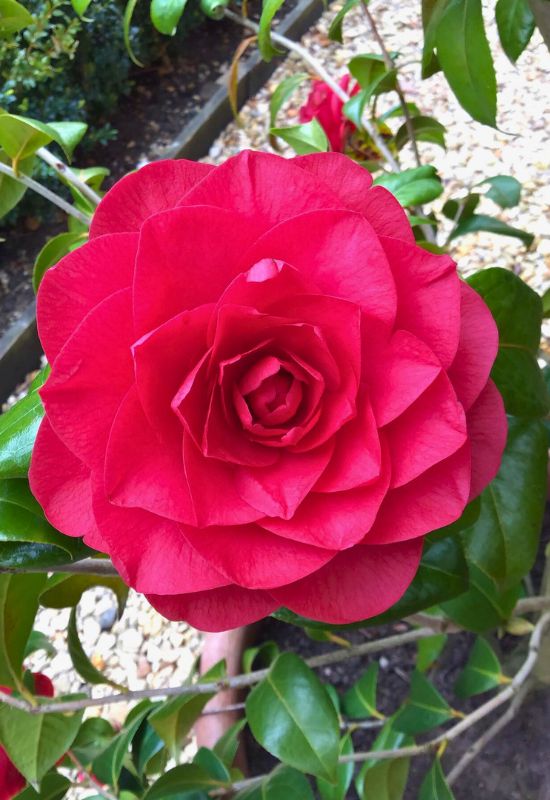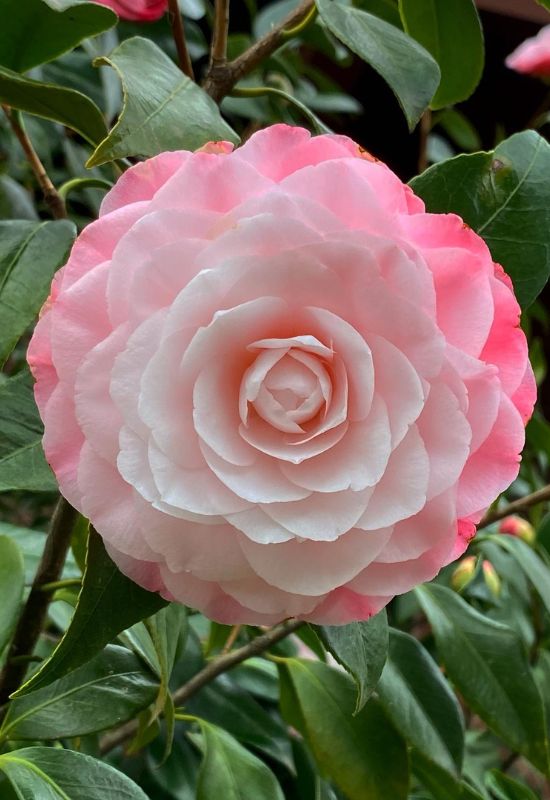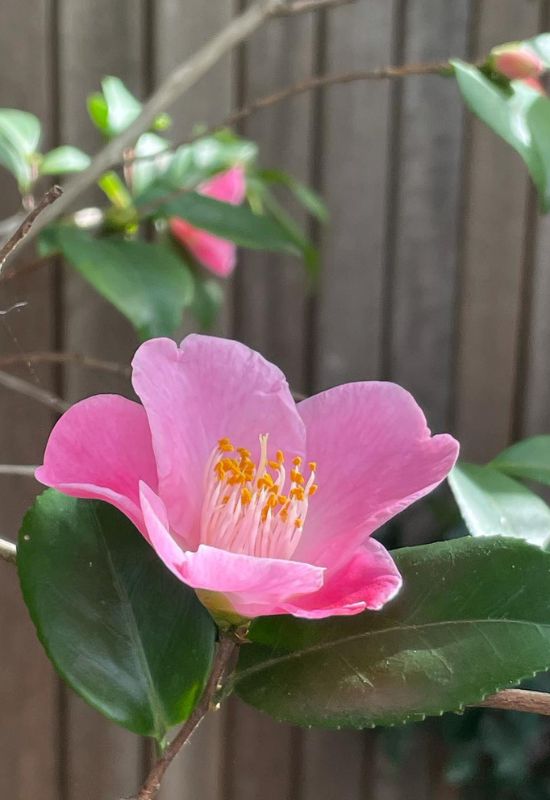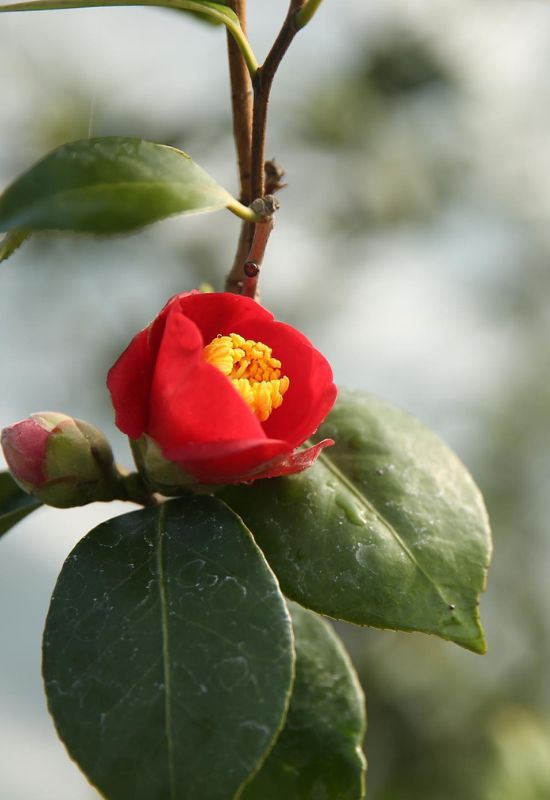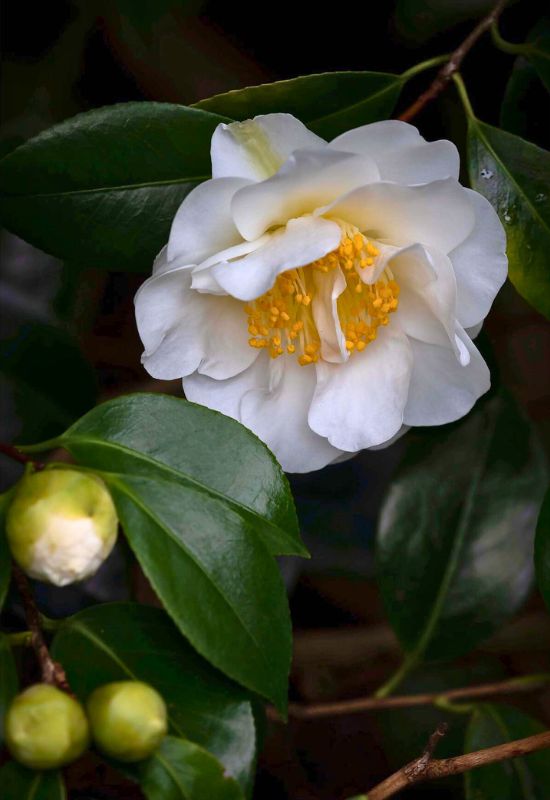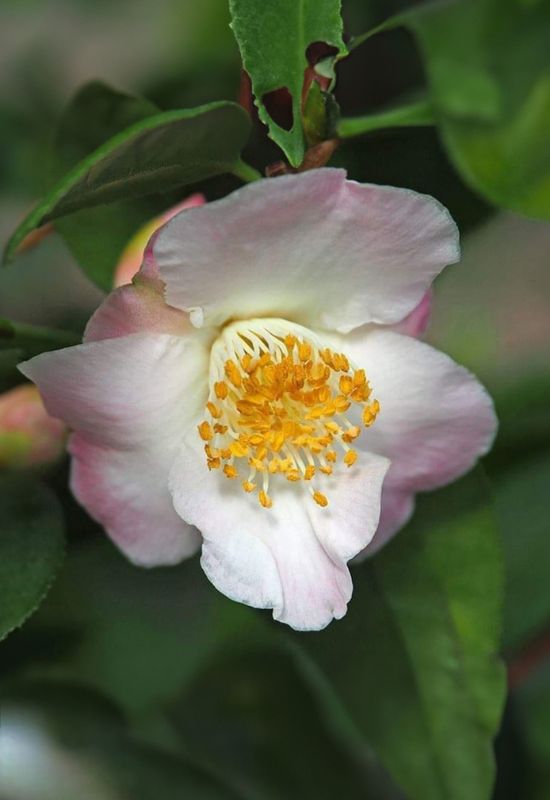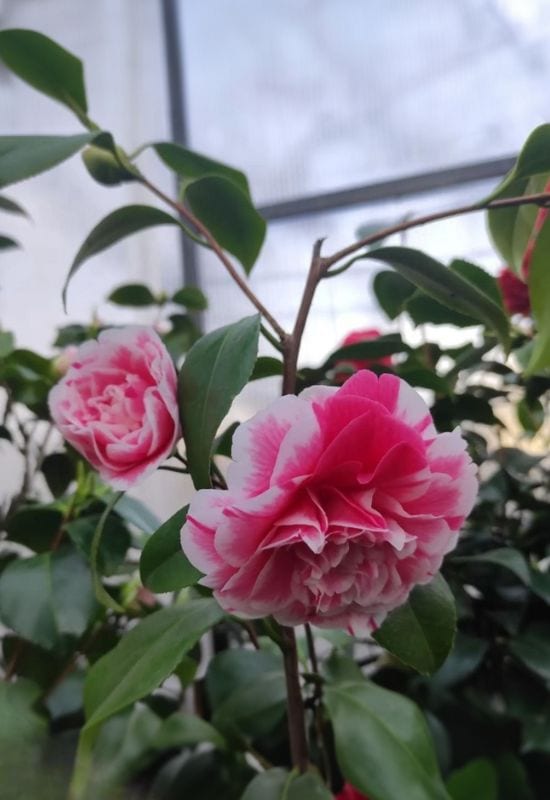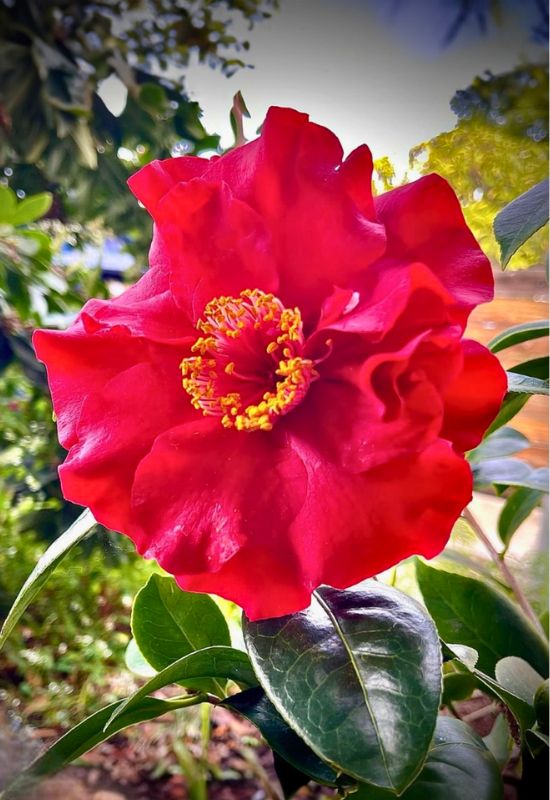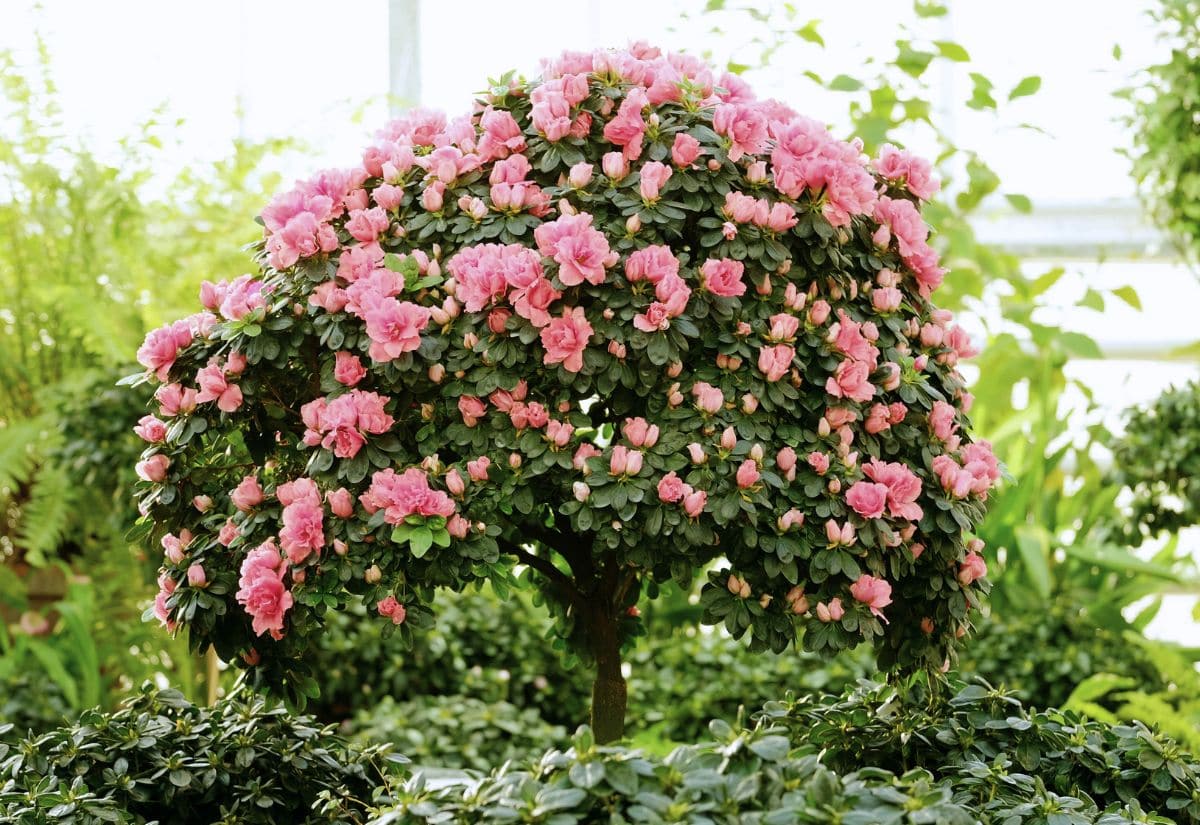
How could you define camellias? I would say the the bright flowering queens of shady gardens…
With their elegant, old world and rose like blossoms, these evergreen shrubs from Eastern and Southern Asia regale our green havens with enchanting blooms in snow white, romantic pink or fiery red, single and double, also peony shaped blossoms, and even opening at the oddest times of the year, like winter!
Few plants can reach the idyllic heights of gentle beauty as does a camellia, in fact… But camellias also have many flower shapes, single, double, formal, informal, like peonies, like roses or like anemones, in white, pink or red tonalities as well!
And there are many, really many camellia varieties! In fact, the Camellia genus has 220 species and at least 21,000 cultivars. The largest flower belongs to Camellia reticulata hybrids, that reach an overwhelming 14 inches across (25 cm), but all are beautiful, and all are different. Named by Linnaeus after Czech botanist Georg Joseph Kamel, this flowering shrub has become a real classic all over the world.
Suitable to most landscaping styles, including Japanese and oriental ones, with an aura of heavenly peace on them, camellias are real treasures in gardens, and we have selected the very best varieties for you!
Before we start, a few details on different types of camellias in gardening are due – also because this flowering shrub has been a protagonist of landscaping for centuries!
Camellia inflorescence types
Apart from the species, there is another way to distinguish camellia varieties: the shapes of their amazing flowers… And, in fact, there are six:
And we will start with the last, because the first camellia you will meet is a real wonder!
17 Extraordinary Camellia Varieties for Your Shady (and Sunny) Garden!
While there are so many varieties, not all are really grown in gardens… The most common species are Camellia japonica, C. sasanqua, C. sinensis, C. reticulata and C. x williamsii. Also Camellia oleifera is grown around the world, but mainly to produce tea seed oil.
Then, there are all the cultivars that breeders have introduced, and we have picked from all of them to give you the most beautiful.
Just look at these camellia varieties… It is not a list, but an Olympic team, because almost all of them have won some of the most important gardening prizes on the planet! And we grouped them by flower shape for you.
Formal Double Camellias
Formal double camellias are some of the most incredible varieties of all, because their many petals are arranged regularly, forming geometric rosettes, and the first we have for you is a clear example…
1: ‘Alba Plena’ Camellia (Camellia japonica ‘Alba Plena’)
The very first variety of camellia I would like you to meet is a real queen of the genus! An heirloom cultivar, introduced as far back as 1797, ‘Alba Plena’ is one of the most iconic of all… In fact, it is a record breaker…
Why? Its fully double blossoms can have up to an incredible 100 petals, to start with! Next, they are arranged with such a geometric regularity, that they look like sculptures, like the rose window of a gothic cathedral!
Reaching 4 inches in diameter (10 inches), they will emerge in mid fall and continue bringing their amazing light to your garden well into winter months… And the color! Its texture, silky, displays a very pale blush of soft pink, only vaguely perceptible, on a white undertone, but at the very center you will notice a little spark of yellow.
It will come as no surprise to you that it has won the most important gardening prize of all, the Award of Garden Merit by the Royal Horticultural Society…
The glossy evergreen and ovate foliage typical of this genus takes on a mid green tonality with luminous ‘Alba Plena’…
A fabulous variety of camellia, ‘Alba Plena’ will naturally take center stage in your garden, even in full shade, and it is so decorative that it could well be a specimen plant.
Suitable to all informal garden styles, it can work well in woodland areas, and also in screens and hedges. Given its outstanding beauty, you may want to have it next to your home for foundation planting…
2: ‘Les Jury’ Camellia (Camellia x williamsii ‘Les Jury’)
‘Les Jury’ is a camellia variety with huge decorative value, and I am sure you will soon see why… The flowers are big, about 4 inches in diameter (or 10 cm), and they will brighten up your garden for about 3 months early in the season (January to March or June to August in the Southern Hemisphere), but they also have other qualities…
To start with the form a rosette that is so regular, so geometric, so sculptural that it will remind you of Echeveria…
The fully double blooms open fully to a sauce shape, revealing broad, rounded and slightly pointed petals that have a very smooth surface, almost waxy indeed! Yet another extraordinary achievement of this hybrid cultivar, however, is the amazingly strong, energetic and bold scarlet to carmine red color that they have.
It is really red at its deepest and most vibrant! And it is another champion, winner as well of the Award of garden Merit by the Royal Horticultural Society. A spreading bush, it will give you the customary glossy and rich green foliage, but with touches of bronze on the new leaves that come on the branches.
For color quality and sculptural plasticity of the blooms, ‘Les Jury’ is just an extraordinary camellia variety; suitable to most informal designs, maybe one of the best for oriental gardens, it deserves to grow in a focal point, but it will adapt to backdrop positions too, like hedges or even woodland areas.
3: ‘Water Lily’ Camellia (Camellia x williamsii ‘Water Lily’)
I suppose the name of this variety has already caught your attention, and this cultivar is really true to its name… ‘Water Lily’ is, in fact, a camellia that will look like the famous aquatic flower we grow in ponds!
Its broad petals unfurl in clear and artistic rows, forming a regular but also soft looking rosette, which can reach 4 inches across (10 cm). The effect is heightened by the bright tonalities that the blooms will display… You will see shades of pink, that go from bubblegum to rose, and they tend to intensify and darken at the margins, also revealing a soft veining pattern that’s very attractive indeed. This tall shrub will also give you blossoms for a particularly long season as well…
Yes, because it will start flowering in mid fall, continue all through the winter months, and all through spring as well! It only takes a break during the hot summer months, where you can still enjoy its evergreen and shiny foliage, which is mid green and particularly healthy for a camellia.
And you have just met yet another winner of the Award of Garden Merit by the Royal Horticultural Society.
Perfect for a romantic, artistic and dreamy garden, ‘Water Lily’ grows into a tall shrub, almost like a tree, and this makes it ideal for hedges and screens, as well for the landscaping uses you would grow other varieties for. It is also an excellent cut flower!
4: ‘Desire’ Camellia (Camellia japonica ‘Desire’)
You may guess that ‘Desire’ has a very romantic, even passionate personality… And you would be absolutely right! And this Japanese camellia variety reaches this intense feeling thanks to its long lasting blooms, which start opening in October and they keep coming all through the winter months, and then in early spring as well!
Fully double, each flower can have up to 69 petals, and they are regularly arranged in a large rosette, 4 inches across (10 cm); the outer ones are broad and round, and then they become smaller and smaller and smaller in the center – and they also take on a triangular shape… The arrangement is regular, but the color gives you a sense of softness and continuity…
Starting from the center of the blossom, you will find white tonalities, but then then it starts blushing to pale pink, then a a deeper shade, and finally even deep rose at the very tips.
It all happens seamlessly, like with the magic of dawn, and this may be why it has received the Award of Garden Merit by the Royal Horticultural Society? And this elegant and dreamy floral display looks even better against the very dark forest green, and glossy evergreen foliage…
A medium sized shrub, ‘Desire’ camellia is a favorite for foundation planting; however, it will bring its long lasting and dreamy blossoms to any informal garden, in borders or hedges or as a specimen plant.
Single Flowered Camellias
As it says on the tin, these camellias have single blossoms, and most are in Nature. They are usually ideal for traditional looking gardens, and we should not underrate them, because they are magnificent in their simplicity. And we can start with gardening royalty…
5: ‘Crimson King’ Camellia (Camellia sasamqua ‘Crimson King’)
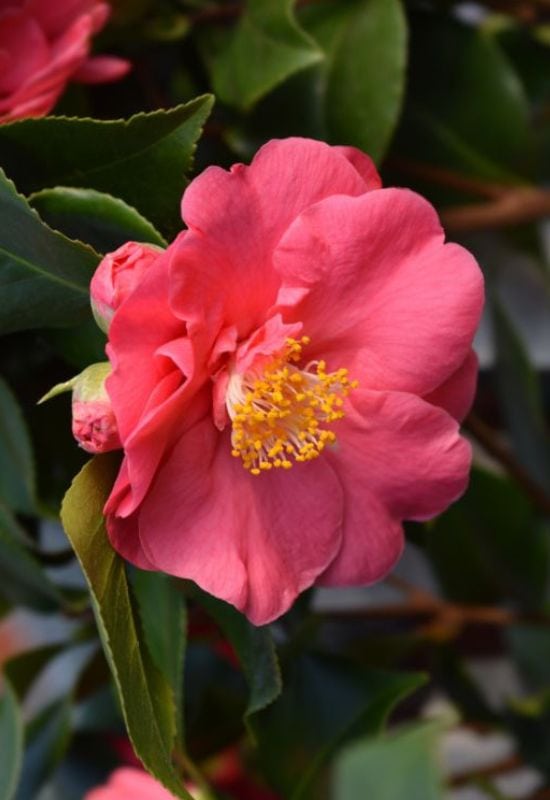
For a totally different variety, I could suggest you look at ‘Crimson King’. This camellia has energy, a bold personality and a striking color…
In fact, its flowers are of the brightest and most vibrant red ever, and, unlike ‘Alba Plena’, it produces single blossoms, and with petals of irregular sizes. In the middle of the flowers, you will also see a rich and dense circle of golden yellow pistils, which adds light and chromatic contrast to the the ensemble.
And you won’t be able to miss it, because each head is about 5 inches across (12.5 cm). What is more, it is also fragrant, and you will see it blooming from October to January (or from March to June in the southern hemisphere).
And it is yet another recipient of the much coveted Award of Garden Merit by the Royal Horticultural Society as well! The leathery and glossy ovate leaves are dark green, adding depth to the floral display.
‘Crimson King’ brings life and very eye catching blooms to winter gardens, and you could grow it in hedges or at the back of borders, as it is a spreading shrub, but also as a specimen or foundation plant, and it too will thrive in naturalized areas. It is also a variety that will tolerate sunny positions.
6: ‘Minato No Akebono’ Camellia (Camellia x lutchuensis ‘Minato No Akebono’)
Here’s the little sister of camellias, and a fairly recent, but very popular single cultivar… ‘Minato No Akebono’ is a hybrid between Camellia japonica and C. lutchuensis, bred in Japan, and it really incapsulates the aesthetics of that country…
The flowers are small, only 1.2 to 2.4 inches across (3.0 to 6.0 cm), but extremely elegant and decorative… They will come in great numbers on the arching branches, giving you the impression of a cherry blossom from the land of the rising Sun…
Yes, because they have a similar deep pink color, and the little petals start off forming a deep cup shape, and they they open out, revealing a lovely tuft of white pistils with delicate golden anthers at the tips.
And you will enjoy thus spectacle for an extremely long time, starting in November, continuing all through winter and coming to a conclusion only in the month of April! The flowers open from brilliant rose buds, which are in themselves very decorative.
The shrub itself is small, but it retains the glossy oval leaves in deep green of other varieties.
‘Minato No Akebono’ is a great single flowered camellia variety for small gardens, even for containers and definitely for foundation planting, and by far a superb choice for a Japanese or oriental garden.
7: ‘Korean Fire’ Camellia (Camellia japonica ‘Korean Fire’)
On to yet another different variety of camellia from the C. japonica species, let’s meet sweet but energetic ‘Korean Fire’. Growing into a large and tall shrub, this cultivar has very unusually shaped blossoms for this genus…
In fact, they are fairly small (about 2 inches across, or 5.0 cm), but they are cup shaped, almost funnel… This gives them a unique personality, quite sweet and welcoming, especially as the round petals fold out to embrace the viewer…
The flowers are red, in tonalities that range from crimson (especially at the tips) to scarlet (especially on the outside). This adds spicy energy and vibrancy to the floral display, and this is a very generous bush indeed. The blooming season lasts through the spring months, and it has an extra touch of light…
In the middle of each flower, you will see a dense golden colored tuft of pistils, and a white stigma emerging from its middle.
Winner of the Golden Award by the Pennsylvania Horticultural Society, it is fairly cold hardy too, and graded with the typically dark and glossy evergreen leaves, but which show shades of copper when they emerge.
One of the best camellia varieties for naturalized areas, ‘Korean Spice’ is a wonderful flowering shrub to inject the energy of fire and the heat of the color red to informal spring gardens, but remember that it needs a sheltered position.
Semi Double Camellias
Semi double camellias have more petals than single flowered ones, but fewer than fully double varieties. You can have a few rows of petals, but when the blossom is fully open, you can still see the center and its reproductive organs. For example…
8: ‘China Clay’ Camellia (Camellia x williamsii ‘China Clay’)
If you are looking for a candid looking and simple variety of camellia, then ‘China Clay’ may be the hybrid cultivar for you… Its flowers are quite large, at about 4 inches in diameter (10 cm) and fully enchanting… They are semi double, with two rows of very, very broad and rounded petals, that keep a cup shape for a long time before they spread out…
Look at them closely, and you may think they are made of icing sugar…Yes, because their texture is very fine, very delicate and very pure…
As is the absolutely pure snow white color that the blossoms display, very bright, luminous, like pure light! In some cases, they may even blush with pale pink…
The round blossoms blooms will brighten up your garden from the tips of the branches from mid winter to mid spring, and they will also display a lovely ring of cream pistils with golden to saffron yellow anthers.
This candor must have convinced the Royal Horticultural Society to reward this shrub with their Award of Garden Merit, while the foliage is less glossy than in other varieties, but healthy and deep green.
The whiteness and soft beauty your garden will get from ‘China Clay’ is unbeatable, especially during the cold season, and it will suit most informal garden styles, but it could be one of the best for a Japanese or oriental landscape.
9: ‘Spring Mist’ Camellia (Camellia x lutchuensis ‘Spring Mist’)
One of the most delicate looking varieties ever, ‘Spring Mist’ is the next camellia I am pleased to present to you…
Its flowers are not big, only about 2 inches across (5.0 cm), but they come in really big numbers for this genus on the branches from October to March (or March to August in the Southern Hemisphere)…
But what makes it exceptional is the shape of the semi double flowers: in fact, they form almost fluted and deep cups, which open a bit more as they mature…
The petals are very light, almost as if made of silk and this very refined effect is then backed up by their color…
In fact, it is of a very, very pale pink shade, just a hint, honest, and a tonality which you can appreciate only if you look closely at them. And then, this hue fades to almost snow white at the edges.
In the center, you will also see cream pistils that end in bright golden yellow anthers. And don’t forget to smell it as well, because it is very fragrant. The contrast with the glossy deep green foliage sets off this floral display perfectly well.
Being a small variety, ‘Spring Mist’ camellia is one of the best you can grow in containers and for foundation planting, or even in shrub borders, but again, feel free to have in other roles as well.
10: ‘Herme’ Camellia (Camellia japonica ‘Herme’)
There are not just varieties in one color, though, for example, look at ‘Herme’! Yes, because this camellia offers you semi double blossoms in rose to pink and then with white margins…
But they are actually quite full, almost to the point of being a fully double variety… And where they meet, these shades form a very fine irregular line, as if they had been pained by an artist and you can still see the strokes he or she has put on the canvas.
Opening to about 3 to 4 inches in diameter (7.5 to 10 cm), the blooms are also fragrant, and the center is adorned by smaller petals that remain in a lovely bud shape until they unfurl…
Then, you will finally see the golden yellow stamens they have been protecting… Its blooming season starts later than many of her sisters, bang in the middle of winter, and it continues till early spring.
But, being evergreen, the dark and lustrous forest green foliage will be lush on the branches to frame this floral display…
‘Herme’ is a camellia variety that hits romantic notes on one side, and it is also very energetic and showy on the other. It can become a very attractive and eye catching flowering shrub to lift up dull spaces, even in full shade.
Peony Shaped or Informal Double Camellias
As you may guess, peony shaped camellias have flowers that look like those of peonies… But how does this come about? These are double varieties, but the petals are not arranged regularly.
What is more, the outer row has bigger petals, while those inside are smaller, and they are called petaloids. The stamens will appear mixed in with these petaloids as well. And here are some magnificent examples.
11: ‘Ballet Dancer’ Camellia (Camellia japonica ‘Ballet Dancer’)
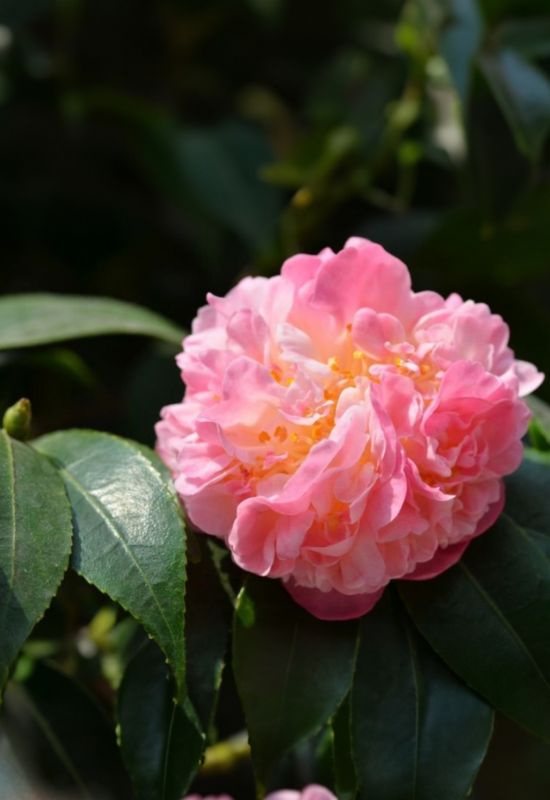
Here’s another camellia variety with an evocative name, ‘Ballet Dancer’ – and very appropriate indeed! It is hard to describe the elegance of its flowers, but I will try…
They are double, and we should say that they are peony shaped. But the petals have from very soft, harmonic shapes, as if in a marble sculpture by Michelangelo…
Tapering to the tips, they form a suave frame for the equally smooth looking petaloids in the middle, which hide brilliant golden yellow pistils. About 3 to 4 inches wide (7.5 to 10 cm), the blooms also display the most sophisticated coloring ever…
You will see hints of rose fade into very soft pink seamlessly, and this shade will then turn to cream tonalities as you move away from the margins and to the center of the blossoms! It will come as no surprise to you that this cultivar is yet another winner of the prestigious
Award of Garden Merit by the Royal Horticultural Society, and flowering from mid winter to early spring, the extremely dark and glossy foliage provides the perfect contrast.
For an elegant and romantic garden, ‘Ballet Dancer’ is one of the best varieties of camellia you can ever grow; it could be both a focal point or a soft and sophisticated backdrop for other flowers…
12: ‘Anticipation’ Camellia (Camellia x williamsii ‘Anticipation’)

Here’s another transformation of the queen of shady gardens: ‘Anticipation’! This camellia has the peony flower shape, on a large scale as well! Each blossom can reach about 6 inches across (15 cm), and it displays large and broad dented petals that enclose smaller, ruffled petaloids in 6 different and concentric rows, giving you a really frilly, soft looking cocarde that looks like it is made of cotton!
This personality is heightened by the intense, saturated color of the blooms. Opening from pointed cream buds, in fact, the flowers have a very strong tonality of pink rose, sometimes even touching on magenta…
And these will come quite profusely at the tips of the branches all the way from early fall to late spring, for a long lasting, romantic but also vibrant spectacle. Winner of the prestigious Award of Garden Merit by the Royal Horticultural Society, it also has very healthy foliage, luxurious and of a very deep green tonality.
A large shrub, ‘Anticipation’ is the ideal camellia variety for an an old world looking garden; grown in hedges or borders, or as a specimen plant, it is hard to match if you like strong pink and soft looking blossoms.
13: ‘Carter’s Sunburt’ Camellia (Camellia japonica ‘Carter’s Sunburnt’)

And we come to another stunning variety of Japanese camellia: ‘Carter’s Sunburnt’. Its decorative value comes from a perfect combination of color and shape.
And size, one could say, because its flowers are 5.5 inches across (14 cm)! But these blossoms are exceptional because they are loosely peony shaped and double, not particularly compact, but this allows you to appreciate the soft, silk like petals that open quite wide…
But there is yet another effect you get…
The irregularly arranged petaloids and petals will also give you a marbled effect!
Soft and smooth at the same time, elegant but irregular, the result of an ivory white background with a dusting of pink and pale rose dots, and sometimes gentle streaks in the same range is superb!
All this elegant spectacle will be with you for an incredibly long season to: from mid fall to mid spring, in fact!
And, guess what?
It too has received the Award of Garden Merit by the Royal Horticultural Society!
The evergreen, glossy foliage of this cultivar follows the delicate and refined theme of its floral display, with mid green as its shade of choice!
‘Karter’s Sunburnt’ is a medium size shrub for hedges, even as a spectacular backdrop to borders, or to give your home a romantic, old world and cottage look with its amazing blooms if you grow it for foundation planting…
14: ‘Karmer’s Supreme’ Camellia (Camellia japonica ‘Karmer’s Supreme’)
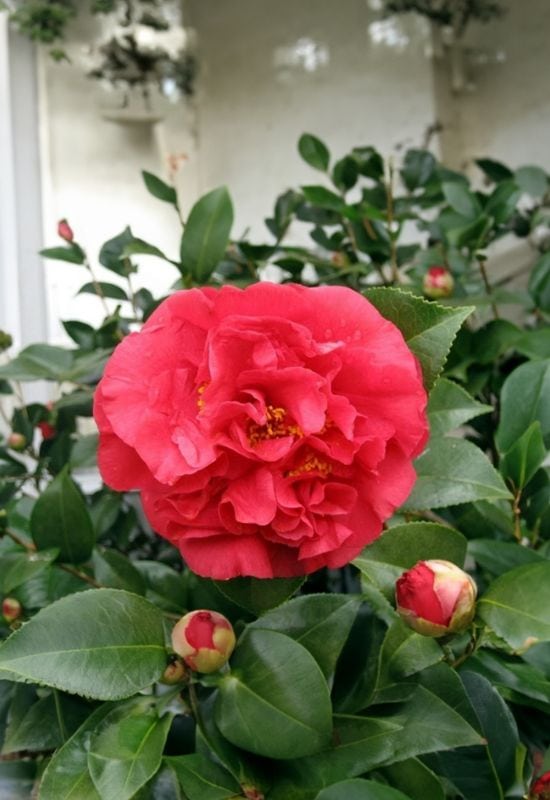
When I said that camellias are the bright queens of shady gardens, I was not joking, and, in fact, ‘Karmer’s Supreme’ is another cultivar that has won the Award of Garden Merit; it looks like the Royal Horticultural Society would agree with me…
But it has also won the Frank Williams Award by the Southern California Camellia Society, the Margaret Hertrich Award and it is on the William E. Woodroof Camellia Hall of Fame: a real champion!
Its large fully double blossoms reach 5 inches in diameter (which is 12.5 cm), but this is not the only reason why it is exceptionally decorative.
While they are peony shaped, the blooms are also original… The outer petals are broad, sometimes gently frilled, and they open fully. On the other hand, the irregularly arranged, rebellious petaloids inside tend to have softly pointed tips, and they too are partly, but only lightly folded…
Add the amazingly strong and decided crimson red color, vibrant and luminous, and you get an idea of what you will enjoy from mid winter to early spring! And look closely, when the flowers will reveal golden yellow stamens as well…
As usual, the leaves are very glossy and ovate, and, in this case, they hit notes of dark emerald.
Maybe more suitable as a specimen shrub, ‘Karmer’s Supreme’ is a medium sized bush that will bring lots of color and amazing blooms to shady gardens in hedges, borders and naturalized, woodland gardens as well!
Anemone Shaped Double Camellias
Once again, the clue is in the title… These camellias look like anemones, and they are double too. But the petaloids are much smaller than the petals, and they form a frilly and irregular collarete in the center, where you will see the stamens crop up in between.
15: ‘Bob Hope’ Camellia (Camellia japonica ‘Bob Hope’)
‘Bob Hope’ could be one of the most energetic camellia varieties ever! And this may be the reason that convinced the Royal Horticultural Society to grant it their Award of Garden Merit…
Let’s start with the flowers…
They are very large indeed, at about 5 inches (12.5 cm) in diameter, and they are semi double. But they also have a collarette shape, similar to those of peonies, because the back petals are very broad, and almost flat, and this allows you to enjoy the velvety texture they display.
On the other hand, the petaloids in the middle are ruffled and smaller, forming an irregular dome…
But there is another striking trait you will not miss: the blossoms hit notes of the most vibrant and intense red ever, along the cardinal to rufous tonalities! And if you look closely, you will notice saffron yellow anthers mixed in with this dynamic floral spectacle…
And they will come for months, firing up your garden in mid winter and and keeping it colorful till early spring. This luxurious show also benefits from from the dark green shade of the very lustrous foliage which keeps healthy all year round.
A show stopping variety, ‘Bob Hope’ camellia will take center stage wherever you grow it. Being a medium sized shrub, it adapts to most shady places in your garden, including containers and foundation planting, bringing vibrant colors and energy.
16: ‘Mine-No-Yuki’ Camellia (Camellia sasanqua ‘Mine-No-Yuki’)
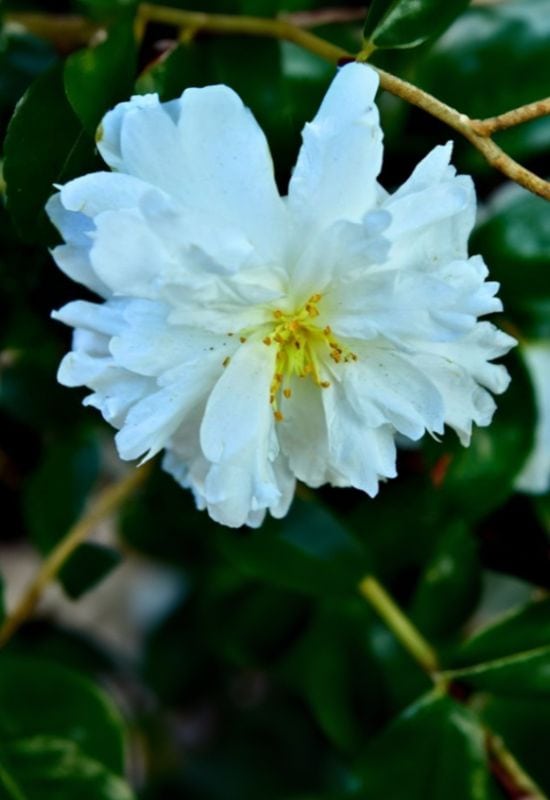
‘Mine-No-Yuki’ is a cultivar of Camellia sasanqua which also has other names, and these are more suggestive, and they may give you a better idea about it.
In fact, it is also known as ‘White Doves’ and ‘Snow of the Mountain’… Yes, you got it: it is a fully super pure white variety!
In fact, it is hard to get a more candid blossom, but don’t worry… It is very generous indeed and you could get up to 150 opening on a single plant! But its delicate look has other traits as well…
One is certainly the frilly, furled and soft textured quality of the petals on the fully double flowers… It has that wedding dress personality that makes it picture perfect for a romantic garden…
Each blossom is about 3 inches across (7.5 cm), opening from round buds with pinkish tips, and if you look closely, you will also see golden yellow pistils with saffron orange anthers popping out among the petals…
This lace like floral display will last from mid fall into mid winter. With mid to dark green, glossy and leathery foliage, it is a really charming shrub indeed.
A medium sized bush, ‘Mine-No-Yuki’ is a perfect backdrop for a border or flower bed, and a must have in a romantic and enchanted Moon garden, but feel free to grow it in other informal situations as well, even in sunny spots!
Rose Shaped Double Camellias
Rose shaped camellias are a rarity; the petals of their double blossoms are rounded but they do not differ a lot in size; they are also bowl shaped, which makes them look like the most loved flower in the whole world. However, they are not very common… But one really stands out, and here it is…
17: ‘Spring Frill’ Camellia (Camellia oleifera x vernalis‘Spring Frill’)
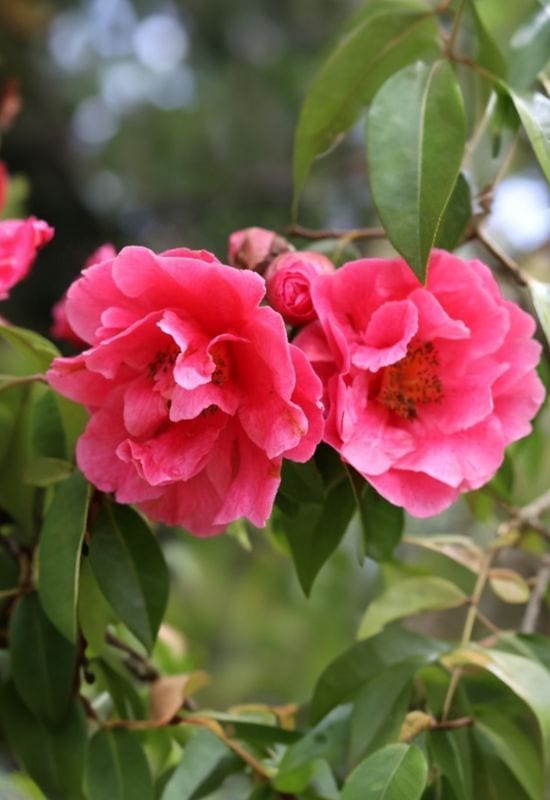
Here’s the little sister of camellias, and a fairly recent, but very popular single cultivar… ‘Minato No Akebono’ is a hybrid between Camellia japonica and C. lutchuensis, bred in Japan, and it really incapsulates the aesthetics of that country…
The flowers are small, only 1.2 to 2.4 inches across (3.0 to 6.0 cm), but extremely elegant and decorative…
They will come in great numbers on the arching branches, giving you the impression of a cherry blossom from the land of the rising Sun…
Yes, because they have a similar deep pink color, and the little petals start off forming a deep cup shape, and they they open out, revealing a lovely tuft of white pistils with delicate golden anthers at the tips.
And you will enjoy thus spectacle for an extremely long time, starting in November, continuing all through winter and coming to a conclusion only in the month of April! The flowers open from brilliant rose buds, which are in themselves very decorative. The shrub itself is small, but it retains the glossy oval leaves in deep green of other varieties.
‘Minato No Akebono’ is a great single flowered camellia variety for small gardens, even for containers and definitely for foundation planting, and by far a superb choice for a Japanese or oriental garden.
Beautiful Camellia Varieties: A Final Tip
How many champions on our list! And of course, camellia is one of the most beautiful flowering shrubs in the whole world! Its amazing blooms and super glossy foliage are its main assets, but sometimes they fail… So, I want to leave you with a final tip, or two…
Keep the soil on the mildly acidic side, and absolutely never alkaline. If it is very hard, maybe because yours is chalk based, grow your favorite gardenia variety in a container, or in a large lined basin, as they do in big gardens and parks.
Next, keep it humid during the summer months, and avoid overfeeding it; never fertilize after July, because these two factors can lead to buds forming, but then dropping from the branches.
Keep these in mind, and you will enjoy their wonderful and long lasting blossoms and evergreen foliage for years and years!

Written By
Amber Noyes
Amber Noyes was born and raised in a suburban California town, San Mateo. She holds a master’s degree in horticulture from the University of California as well as a BS in Biology from the University of San Francisco. With experience working on an organic farm, water conservation research, farmers’ markets, and plant nursery, she understands what makes plants thrive and how we can better understand the connection between microclimate and plant health. When she’s not on the land, Amber loves informing people of new ideas/things related to gardening, especially organic gardening, houseplants, and growing plants in a small space.

